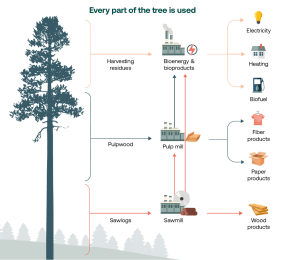As part of the European Commission’s efforts to revise its Bioeconomy Strategy, the initiative “Towards a circular, regenerative and competitive bioeconomy” seeks to place the sustainable use of biological resources at the heart of the EU’s green transition. Through an open public consultation, the Commission is gathering input from stakeholders across Europe to shape policies that will support climate neutrality, enhance circularity, and strengthen Europe’s long-term competitiveness.
The following proposals and positions represent the response submitted by FAM, which advocates for a strong forest-based bioeconomy as an essential pillar in Europe’s sustainable transformation. The input emphasizes innovation, flexibility in forest management, and the strategic role of forests in replacing fossil-based materials across industries.
Forests and the bioeconomy: a strategic opportunity
In the race toward a climate-neutral future, the European Union’s evolving Bioeconomy Strategy highlights one crucial truth: forests and bio-based innovation are not just part of the solution—they are central to it.
Forests are among Europe’s most strategic resources. Beyond their cultural and ecological significance, forests provide renewable materials that can drive economic growth, reduce dependency on fossil fuels, and enable the creation of circular, low-carbon industries. As Europe seeks to replace fossil-based products with sustainable alternatives, the forest-based bioeconomy offers unique advantages.
From fossil fuels to forest fibres
A core principle of the strategy should be to increase substitution. I.e. replacing fossil-derived products with renewable, fibre-based materials. Bio-based products like timber construction materials, textiles, bioplastics, and even biofuels can significantly lower the EU’s carbon footprint. These alternatives already exist and are rapidly scaling, especially with the rise of electric vehicles and climate-friendly infrastructure.
However, for this transition to be effective, fossil fuel subsidies must be phased out. Leveling the playing field would allow bio-based innovations to flourish, incentivizing investment and accelerating decarbonization.
Sustainable forest management: a flexible approach
One size does not fit all when it comes to managing Europe’s diverse forests. Sustainable forest management must be tailored to regional conditions and empower individual forest owners with the flexibility to make responsible, site-specific decisions. Recognizing forests, forestry, and wood-based products as strategic assets would reinforce their vital role in achieving climate and biodiversity targets.
A predictable and efficient policy framework
To foster innovation and long-term investment, the forest-based bioeconomy needs a stable, predictable regulatory environment. Legislation should not only reflect environmental goals but also promote competitiveness and efficiency. This includes reducing regulatory burdens and ensuring that impact assessments account for the cumulative effects of overlapping rules.
Appointing a Forest Principal Adviser to the European Commission could help coordinate policy, streamline administration, and facilitate meaningful dialogue between EU institutions and the forest sector.
Building a circular, carbon-efficient economy
The circular economy concept is embedded in forest-based industries. Virtually every part of a tree is used: high-quality logs become construction materials, while residues feed into pulp, paper, biochemicals, and bioenergy. After their initial use, wood products can be recycled or converted to energy—ensuring minimal waste and maximum climate efficiency.
Supporting technologies like Bio-CCU (carbon capture and utilization) and Bio-CCS (carbon capture and storage) will be essential to recognize and reward the long-term carbon storage potential of forest products. Meanwhile, lead markets—such as public procurement for timber buildings—can boost demand and accelerate adoption.
Unlocking the potential of biomass
As fossil carbon is phased out, sustainable biogenic carbon—especially from forests—will be in high demand. Policies should support increased forest growth through reforestation, afforestation, and the use of underutilized lands. Yet, this must be achieved without imposing additional sustainability criteria, which risk creating unnecessary complexity and misalignment. Existing regulations already ensure strict environmental safeguards.
Toward a fossil-free future
Finally, the EU’s climate policy architecture must evolve to fully account for the climate benefits of substitution, where renewable forest products replace fossil-based alternatives. Establishing clear reporting and incentivizing substitution effects could be a game-changer for unlocking the full potential of the bioeconomy.
In sum, a thriving bioeconomy is essential for a sustainable, competitive, and climate-resilient Europe. With the right incentives, streamlined regulations, and a commitment to innovation, the EU can lead the world in developing smart, renewable, forest-based solutions.
Read FAM’s entire response here.




